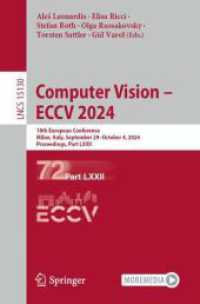- ホーム
- > 洋書
- > 英文書
- > Cinema / Film
Full Description
Argues that Indian cinema's deep nineteenth-century past continues to play a vital role in its twenty-first-century present.
In A Very Old Machine, Sudhir Mahadevan shows how Indian cinema's many origins in the technologies and practices of the nineteenth century continue to play a vital and broad function in its twenty-first-century present. He proposes that there has never been a singular cinema in India; rather, Indian cinema has been a multifaceted phenomenon that was (and is) understood, experienced, and present in everyday life in myriad ways. Employing methods of media archaeology, close textual analysis, archival research, and cultural theory, Mahadevan digs into the history of photography, print media, practices of piracy and showmanship, and contemporary everyday imaginations of the cinema to offer an understanding of how the cinema came to be such a dominant force of culture in India. The result is an open-ended and innovative account of Indian cinema's "many origins."
Contents
List of Illustrations
Acknowledgments
Introduction
Part I: Obsolescence
1. The Nineteenth-Century Indian Techno-Bazaar
2. Traveling Showmen, Makeshift Cinemas: The Bioscopewallah and Early Cinema
Part II: Mechanical Reproduction and Mass Culture
3. Copyright and Cultural Authenticity: The Politics of Mechanical Reproduction in South Asia
4. The Cinema as Mass Culture: The Melodramas of Mechanical Reproduction
Part III: Intermediality
5. The Emergence of Topicality: Snapshot Cultures and Newspaper Photojournalism
6. Politics across Media: The Partition of Bengal (1905) and the Cinematic City
Part IV: Archives
7. The Abundant Ephemeral: The Protocols of Popular Film Historiography in India
8. Postscript
Notes
Works Cited
Filmography
Index






